CHAPTER XIII
THE CHURCHES OF SAUNDERS COUNTY
Saunders County is a county of many churches and comparatively few denominations. The large part of the congregations is small and could very profitably be united into larger and more prosperous societies. However, the churches have existed through many years and have done splendid work. The principal denominations in Saunders County are the Swedish Lutheran, the Bohemian Catholic and the Swedish Mission. The former and the latter are practically synonymous, until the beginning of the '70s having been the same church denomination. At this time the great schism occurred in the church, for reasons which cannot be given in a history of this scope, and the revolutionists became known as the Swedish Mission Society. This split-up happened just about the time of the beginning of the Swedish churches in Saunders County, consequently both had their inception here at the same time.
The Swedish Evangelical Lutheran Bethlehem Church at Wahoo is the principal church in the county of this denomination. The missionary work preceding the organization of the Bethlehem congregation was begun by Rev. Nels Nordling in the fall of 1880. Reverend Nordling was at that time pastor at Malmo, Nebraska. He moved away in 1881 and was succeeded by Rev. J. P. Nyquist, who also continued the missionary work at Wahoo. Rev. L. P. Ahlquist, pastor at Mead, conducted services at Wahoo a few times also. In the spring of 1883 a split was caused among the Swedish church people by the Swedish "Mission Friends." In July of the same year Rev. M. Noyd came to Wahoo as the president of the newly organized Luther Academy and then also took charge of the church work among the Lutherans here. On Christmas Day, 1883, Rev. M. Noyd organized
163
164 PAST AND PRESENT OF SAUNDERS COUNTY
the Swedish Evangelical Lutheran Church of Wahoo, with seventeen charter members. Among these was S. P. Wahlstrom, who is still a member of the church. All the rest have either died or moved away since that time. On February 26, 1885, the small congregation held a meeting and decided to build a church. The lots, on which the present church building now stands, were purchased. But this was as far as the work could be carried at the time. In 1887 Reverend Noyd moved away. The congregation did not succeed in getting another pastor until 1889, when Rev. A. P. Fors took up the work. He did splendid work both for the upbuilding of the congregation and Luther Academy and it was with much regret that his parishioners saw him leave in 1890. The next pastor was Rev. John Ekholm, who had charge of the congregation from July 1, 1891, until August, 1893. The congregation was then without a pastor until August 1, 1895, when Rev. J. E. Erlander took charge. He remained pastor of the congregation until November, 1899. There was again a long vacancy, until January, 1902, when Rev. O. J. Johnson came to Wahoo and entered upon his duties as pastor and as president of Luther Academy. He remained until July, 1913, then moved to St. Peter, Minnesota, to take the chair of president of Gustavus Adolphus College. The present pastor, Rev. Oscar Sandahl, has had charge of the congregation since December 12, 1913.
In July, 1887, the erection of the first church building was begun and it was ready for use September 2, 1888. That edifice was used until June, 1906. The congregation had increased in numbers and the old building was not adequate for the needs of the work carried on by the church. The cornerstone of the new church was laid October 6, 1906, and on Sunday, May 12, 1907, the first services were held in the building, and on the following Sunday, May 19th, the dedication took place. From a small beginning with only seventeen communicant members the congregation has grown to 295 communicant members and 376 baptized members in 1915.
In 1893 the congregation purchased a house to; be used as a parsonage. This served until 1914, when a modern home was erected at a cost of $5,400. The congregation now owns a church property valued at $26,300. The following persons have served as organist in the church: Dr. S. M. Hill, eleven years; F. J.
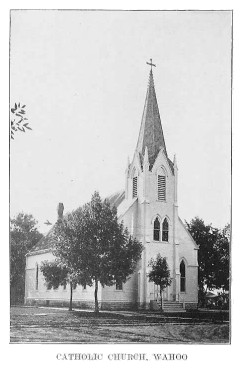
Catholic Church, Wahoo
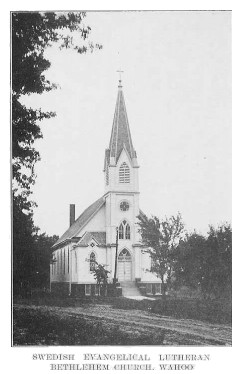
Swedish Evangelical Lutheran Bethlehem Church, Wahoo
PAST AND PRESENT OF SAUNDERS COUNTY 165
Johnson, two years; Miss Josina Erlander, four years; Miss Anna Swan, one year; Daniel T. Sandell, one year; Miss Esther Monteen, one year; A. O. Peterson, eleven years; Miss Florence Almquist, the present organist, one and one-half years. The work in the congregation is carried on, besides the regular work of the pastor and officers of the church, by the following societies:
The Mission League (Ladies' Aid); The Luther League (Young People's); The Dorcas (Young Ladies'); The Willing Workers (Young Girls'); the church choir, children's chorus and the Sunday school.
The Swedish Evangelical Lutheran Mission at Mead was organized on July 1, 1876, by Rev. John A. Peterson, and Rev. A. N. Sweders was the first pastor. The first church building was constructed in 1877 and the second and present one in 1891. The first members were C. J. Edoff, Fred Sabelman, John Sabelman, Christ Gustofson, A. F. Johnson, C. J. Carlson, John Olson and Andrew Nelson. The present membership is seventy-one and the pastor is Rev. R. E. Swanson.
The Swedish Lutheran Church at Valparaiso was organized in 1871 and has maintained a steady growth since this time. The church at present has about one hundred and twenty-five members and is housed in a comfortable church structure. The Swedish Evangelical Lutheran Church at Malmo was organized in April, 1870, and the first building was put up in 1877, the second in 1890 and the last one in 1914, costing $13,000. There are 206 communicant members in this society. A parochial school is held for one month each summer. The Swedish Mission at Malmo was started in 1876 and the same year a building was constructed two miles north of the present town site. This was used until 1901 and was then enlarged and remodeled and in December, 1904 was sold. The new building was dedicated February 4, 1906, and cost $11,585. The Swedish Mission Church at Ceresco was started in 1871. The Swedeburg Lutheran Church was organized in 1870 and incorporated in 1884. A frame church was constructed in 1887. There are 494 parishioners at present. This church has just completed a magnificent new church building, which is one of the finest in the county. Alma congregation, Swedish Lutheran, at Mead, was organized in 1870, and incorporated in 1870 A frame church building was constructed in
166 PAST AND PRESENT OF SAUNDERS COUNTY
1886. There are 171 communicant members. The Swedish Baptists also have a charge in Mead, conducted by Rev. C. G. Samuelson.
The first Bohemian Catholic settlers in the vicinity of Wahoo were: W. Simodynes, Jacob Novotny, Thomas Zimola, Frank Konecky and Frank Noha. They came to Wahoo on Assumption Day, August 15, 1874, from Moravia. They were not so poor as the majority of emigrants were usually, but brought hundreds of dollars with which they bought farms. They were liked by their American neighbors because they had temperate habits and had cash. Being unable to talk English they experienced all the difficulties of emigrants. When they went to the store they had to go from one shelf to another and designated with their finger what they wanted. All these first settlers were good Catholics and remained faithful to their doctrine which was preached to their forefathers by the great apostles of Moravia, St. Cyrillus and Methodius. They were accustomed to hear mass every Sunday, Hold Day and even on weeks days, but here they found no Catholic Church and no priest for miles. They heard that a Bohemian priest, Father Bobal, would say mass in a schoolhouse near Plasi, more than sixteen miles distant. Here they hastened for worship.
The following year, 1875, another party of emigrants from Moravia came to Wahoo and the number of Bohemian Catholic families was increased to ten. The same year Father Bobal again visited Saunders County and said mass in the schoolhouse near Plasi. On his way home he visited the Wahoo Catholics, stayed with them for two days and said the first mass in the vicinity in the house of Frank Konecky, 2 1/2 miles from Wahoo.
On July 9, 1877, Father Sulak of Chicago came and said the first mass in Wahoo, Saturday and Sunday in the public school and Monday in the courthouse. That day the first Bohemian wedding took place, namely, that of John Simodynes and Tonie Svoboda. When there was no mass at Plasi the Wahoo Catholics went to Fremont, twenty-two miles distant.
In the year 1877 Father Joseph Hovorka from Albie (November 17th) said mass in the courthouse and married John Prokes and Annie Simodynes. The number of Catholics was increasing month after month and the necessity of a church and regular
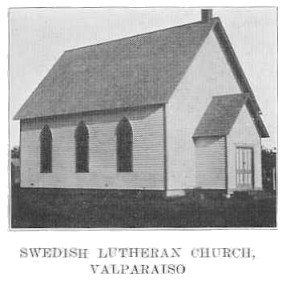
Swedish Lutheran Church, Valparaiso
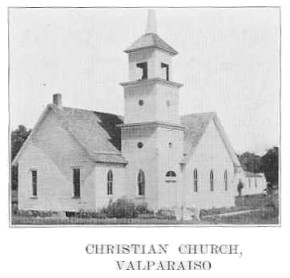
Christian Church, Valparaiso
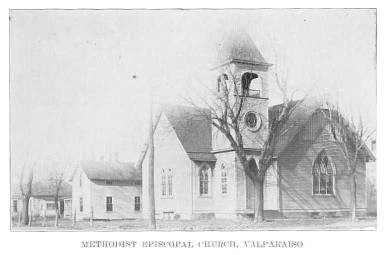
Methodist Episcopal Church, Valparaiso
PAST AND PRESENT OF SAUNDERS COUNTY 167
services were plainly evident. The first meeting of Catholics was called in 1877 and the plan of buying a large store at Cedar Hill, which was for sale, and using it for a church, was discussed. This was thought to be too distant, however, and it was decided to construct a church in Wahoo. Work on the new church was commenced in July, 1878, and was finished the same year, so that the first mass in the new church could be celebrated by Father W. Kocarnik at the end of the year. The church was 30 feet wide and 50 feet long and was a perfect imitation of the church at Plasi. The cost was $7,500. Father Kocarnik visited the congregation every third Sunday.
On September 28, 1884, St. Wenceslaus Day, Father Stutz visited the Wahoo congregation for the first time. He continued until October 4, 1885, when Father Choka of Omaha said his first mass. The latter attended Wahoo twice each month until February, 1889. During his administration the Sacrament of Confirmation was administered by Rt. Rev. Bishop Bonacum on July 4,1888.
On March 9, 1889, Rev. M. Bor was assigned as pastor of Wahoo, Weston and Brainard, with residence at Colon. After two months he moved to Wahoo, where a residence for the priest was constructed at a cost of $1,000. The house was ready September 27, 1889. On October 9, 1889, Reverend Bor was transferred to Wilber and was succeeded by Rev. Alois Klein, who remained until November, 1891. During his administration the congregation erected a new church on Linden Avenue at a cost of $3,600. The work on the building began in the spring of 1891 and was finished in December. When Father Klein left Rev. E. Bouska said mass twice in Wahoo, and he was succeeded by Rev. M. Bor, who again became pastor February 6, 1892. The first mass in the new church was said by him June 5, 1892.
In the spring of 1893 the house was removed from the old place to the new church and enlarged. The dedication of the new church and the sacrament of confirmation was administered by Rt. Rev. Bishop Bonacum on July 4, 1895, to sixty-two persons. Rev. M. Bor continued in the pastorate of this church until February 27, 1915, when he went to the church at Weston. Rev. J. Hncik succeeded him at Wahoo. The splendid St. Wenceslaus
168 PAST AND PRESENT OF SAUNDERS COUNTY
school, of which there is a view in this volume, was built in 1911 and is a credit to the Catholics of Wahoo and vicinity.
When the Plasi church of the Bohemian Catholic denomination was built forty acres were purchased and this ground was kept for the burial ground known as Cuda Cemetery. They purchased another forty acres ?/? miles from Weston and wished to build a church there. However, the majority were in favor of Weston and accordingly ground was bought in that town in July, 1885. There were eighteen families there and a small frame church was put up. The church was attended by Father Stutz from Plasi and the first mass was held December 8, 1885. Father M. Bor is now in charge of this congregation. The St. John's Church at Weston dedicated a handsome new church building in July, 1906. This church cost the sum of $17,000. It was 42 by 101 feet in dimension. The fancy windows were donated by Frank A. Capek, Karel Vican, Frank Hakel, Joseph Jisa, Joseph Lukas, L. J. Kovanda, John Bartek, Jakub Bone, Peter Rezek, Frank Meduna, John Maly and family, John Masek, J. Hejtman and Frank Tomes. The sanctuary lamp was given by Andrew Tomes; three pairs of candlesticks by Vaclav Jansa, N. P. Anderson, John Pospisil, and others. The building committee was composed of Father Bor, Frank Hakel, L. J. Kovanda, Joseph Woita, John Bartek and Frank Dolezal. A splendid parsonage has also been erected adjoining the church building.
The first church at Prague of this denomination was in 1899 and was in charge of Father John Vicek, then of Plasi. It was just a mission. The first regular pastor was Father John Novotny in 1904. Reverend Novotny stayed until May, 1908, then Father Pokorney, the present pastor, took charge of the congregation. The society has seventy members and a handsome church building, as well as a comfortable parsonage.
The first church of the Bohemian Catholic people was at Cedar Hill, in Bohemia Precinct; then came the Plasi church. Touhy church was started in 1903. For two years prior to this the people of Touhy had attended at Weston, but in 1903 a collection was taken up and a church built which cost $9,000. There were twenty-five members at the start and there are now fifty. Father M. Bor attended the church in 1903-04, but now Father Gryc of Plasi has charge. Other societies in the county are at Valparaiso, Estina, Miloy, Sand Creek and Mead.
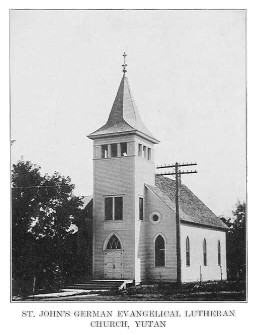
St. John's German Evangelical Lutheran
Church, Yutan

German Reformed Church, Yutan
PAST AND PRESENT OF SAUNDERS COUNTY 169
The Reformed St. Peter's Church at Yutan was organized in 1875 and reorganized March 21, 1880, by Rev. Frederick Hullhorst. He was also the first pastor of the congregation. The first church building was put up in 1880 and the new one in 1913, following the cyclone. At present there are about eighty members and the pastor is Rev. Carl Iffert.
The German St. John's Evangelical Lutheran Church at Yutan was organized May 27, 1901, by Rev. G. A. Neeff, Ph. D., with thirty-six charter members. The church was constructed in 1901 and rebuilt after the destruction by the tornado of 1913. There are now 90 communicant members, 180 confirmed and 294 baptized. Rev. P. Bieger has been the pastor since 1909. The first members were: John F. Kolb, William Miller, Henry Heuck, John Schulz, Fritz Stamp, Fritz Goersz, Carl Burmeister, F. Utesch, J. Utesch, John Stamp, Fritz Karloff, Fritz Kruger, N. Miller, Carl Trost, Christian Trost, J. H. Karloff, John Sieverkropp, Wilhelm Buehrig, Karl H. Utesch, Fritz Utesch, Christ. Passow, Gustav Nitz, Gustav Konagel, W. Mahlendorf, D. Heldt, John Krohn, W. Karloff, C. Sagert, William Sagert, Hans Wicht, William Burmeister, Peter Jacobs, Detlev Siebken, A. Voelker, Christ Nissen.
The German Methodists and English Methodists both have churches at Ithaca, the latter being the oldest of the two. The Methodist Episcopal Church at Morse Bluff was organized in 1913 by Reverend Jordan, with eight members. There are now twenty-five. Rev. G. M. Jones is the present pastor of this church. The church building was dedicated June 22, 1914. Iliff Chapel at Memphis was built in 1880 and rededicated September 6, 1908.
The history of the different religious societies which have flourished in Wahoo and vicinity begins with the year 1868, at which time Reverend Giddings, a missionary, came to Wahoo upon invitation of J. M. Lee and preached the first sermon in the town at the home of the same Mr. Lee. For two years after this services were held in the schoolhouse. In 1870 Reverend Giddings organized the Congregational Church of Wahoo. The church held its services in the schoolhouse in 1880, when a comfortable church building was erected. This building was burned February 13, 1909. A new church was then put up and dedicated February 20, 1909; it cost $4,900.
170 PAST AND PRESENT OF SAUNDERS COUNTY
The Reformed Presbyterian Church was organized December 19, 1871, as the Fremont and Wahoo Reformed Presbyterian Church. Rev. D. McKay, commissioned by the Kansas Presbytery, performed the initiatory services in the schoolhouse, which was about two miles out of the Town of Fremont. A church was constructed at Wahoo in April, 1873, and was valued at $1,200. The first regular pastor was Rev. J. A. Thompson; the society held some of the earlier meetings under his charge in the school-house, which was before the above mentioned church building" was erected.
The next society organized in the town was the Presbyterian. This was in 1874 and came about through the efforts of Rev. William Fletcher, a missionary, sent by the Iowa Presbytery. Services were held in the schoolhouse until the first church building was put up in 1878, and the pulpit was supplied until 1877, when Reverend Amlong became the pastor. In March, 1915, the building was sold for $160 to Mr. Lindquist and the society bought the Reformed Presbyterian building.
The Methodist Episcopal Church organized its first class in 1873, at the schoolhouse in the Town of Wahoo, with a very small membership. A church building, costing $2,500, was erected in 1881.
The Baptist Church was organized in 1876 and built its first church in 1878. Rev. Washington I. Price was the first pastor.
The first services known to have been held in Wahoo by the Episcopalians was on Sunday, October 4, 1885, by Bishop Worthington and Rev. J. Hewitt, then in charge of St. James of Fremont. The services were held in the Baptist Church. Beyond occasional visits to the town nothing more was done for some time until Rev. W. H. Sparling, then archdeacon of general missions of the diocese, visited the town on April 19, 1892, and found eleven communicants. Occasional services were then held until March of 1893, when, assisted by Dean Gardner, he held a week of services and presented the first confirmation class. From that time services were held on alternate Sundays in the Danish Lutheran Church, sometimes by Sparling and sometimes by Canon Whitmarsh, until June, 1896, when Rev. Irving Johnson, as district presbyter, was placed in charge. The church building was dedicated February 20, 1897.
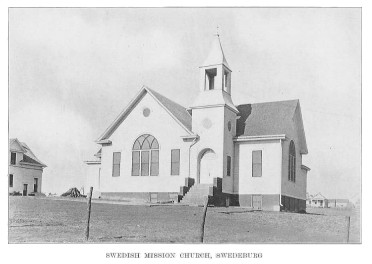
Swedish Mission Church, Swedeburg
PAST AND PRESENT OF SAUNDERS COUNTY 171
The Methodist Episcopal Church of Cedar Bluffs began even earlier in this community than the town itself. Services were regularly held in the old grange hall which then stood half a mile southeast of the town. The first Methodist Church was built one mile south of Cedar Bluffs, during the pastorate of Rev. A. J. Calvert. Then when Cedar Bluffs began, the building was moved and located in the south part of town. The new church building was constructed during the pastorate of Rev. J. W. Royce. The pastors who have served this congregation have been: Revs. E. J. Bird, T. A. Hull, D. Y. Black, C. W. Shaw, W. H. Turrell, R. A. Barnes, J. W. Royce, E. Cobb, E. S. Burr, E. L. Wolfe, C. E. Austin, H. Royce, and Charles Burns.
For a long time the Methodist Episcopal Church was the only one in the town and there came a feeling to the people that there should be another denomination located in Cedar Bluffs. No leader for this movement was found until March, 1905, when Mrs. Sophia Thomas Staats and R. J. Fleming took hold. The former called on Rev. Clarence W. Weyer at Fremont and invited him to take up a Presbyterian mission here. No encouragement was received at this time. On Decoration Day she called again and he consented to take up the work. In the meantime Mrs. Fleming and Robert Mowbray had circulated a paper for charter members, over forty-five of whom were secured. An additional $2,000 was secured and the foundation of the church laid before the church was organized. The first meeting was held September 25,1904, and was in charge of Reverend Weyer of Fremont.
The first missionary who ever visited Saunders County was Rev. I. A. Martin, who came to Ashland in 1865. He remained but a short time, but during his stay he organized the First Baptist Church of Ashland on July 8th of the year in which he came. This was the first church to be organized in the county. The church society was formed mainly through the efforts of Dennis Dean, who was also its first and only deacon for quite a length of time. The names of the pioneer members were; Dennis Dean and wife, William Anderson and wife, Joseph Arnold and wife, Mrs. Barnhill, Mrs. Biggs and Mrs. Laura Brush. A short time after its organization funds were raised with which to build a church, but the society loaned them to the school district and after the schoolhouse was erected they held their services therein, or
172 PAST AND PRESENT OF SAUNDERS COUNTY
until the brick edifice was built in 1870. The first resident pastor of the church was Rev. C. A. Miller. He settled in Ashland in 1867, and stayed until 1873. He was succeeded by Rev. J. N. Webb.
In the recounting of the history of the Methodist Episcopal Church of Ashland no better wording can be secured than that of A. B. Fuller, one of the pioneers of the vicinity. He writes: "Many of Ashland's citizens will remember Joseph Throckmorton and his early labors in behalf of the Methodist Church. It is related of the old gentleman how he prayed earnestly for the destruction of a certain groggery, situated near or at the settlement called Shatters, about three miles from Ashland, and, as if a kind of Providence had answered his prayer, a terrible hurricane came and swept it almost out of existence. The owner came to remonstrate with him as the cause of all his late misfortunes and the old gentleman told him 'to desist and lead a better life or he would pray God to wipe him out also.' He labored in sod houses and dug-outs and in time became a noted character in the surrounding settlements and was even feared and reverenced by some. The history of this church is a tale of hardship. Reverend Swarts came to Ashland as a missionary in the winter of 1868 and organized its first class. Joseph Throckmorton and his wife headed the list of the first class, followed by Emma A. and Ella M. Throckmorton, P. A. Gould and wife, Alzina Block, Rodney Dexter and wife, James E. Aughe and wife, Mrs. C. Cole and John Aughe. In the spring of 1869 Reverend Munhill was sent to Ashland and preached the first series of sermons. The society met at Snell's Hall until January 30, 1870, when, on this particular morning, upon going to service, they found the hall rented and themselves locked out. After this they held meetings in unfinished buildings, sometimes piling shingles and lumber for a pulpit, while the congregation sat upon improvised seats. In May, 1870, Rev. Charles Munson came to Ashland, but remained only until the following summer, and during this year the church was built. In 1871 Rev. D. Blake officiated; in 1872 Deal and I. L. Simington. In 1875 Rev. A. L. Folden was given charge of Ashland by the annual conference and upon his arrival here was informed that the society was almost bankrupt and could not support him, being heavily in debt for the church. It was a gloomy

Baptist Church, Ashland
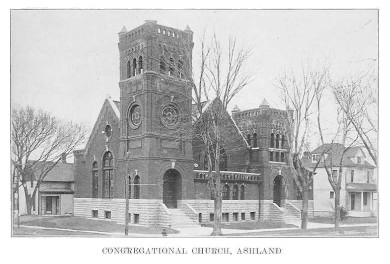
Congregational Church, Ashland
PAST AND PRESENT OF SAUNDERS COUNTY 173
outlook, but he went to work with a determination and energy that we may honestly admire. Under his administration the church was completed and freed from debt. Ashland passed through one of the strongest and most stirring religious revivals it ever has experienced. Its membership increased and the church secured a foothold which if has ever maintained."
Rev. Asa Farwell organized the First Congregational Church in 1872 and was the pastor of the society until 1877, when he was succeeded by Reverend Leavitt.
In compliance with the canons of the Protestant Episcopal Church of the Diocese of Nebraska a meeting to organize a parish at Ashland was held in the public hall at the latter town on July 10,1871, and the following voters were present: A. B. fuller, J. B. Lininger, C. H. Walker, O. M. Carter and Richard Gray, M. D. Mr. Walker was elected secretary. The constitution of the diocese was adopted and the parish was named St. Stephen's. O. M. Carter was chosen senior warden and Doctor Gray junior warden. J. B. Lininger, A. B. Fuller, C. H. Walker, William Haynes, G. H. Bascom, were vestrymen: J. B. Lininger was treasurer; Richard Gray, collector. A building committee, consisting of A. B. Fuller, O. M. Carter and the rector, Rev. Samuel Goodale, was appointed. The church was completed in 1872 and Reverend Goodale officiated until 1874.
In the summer of 1869 Rev. George Worley preached the first sermon in Valparaiso, his congregation meeting under no protection but the open sky. In the winter the dugouts of the people became the meeting-houses for the class. This same Reverend Worley performed his spiritual labors in many parts of the county and, in fact, was the first circuit rider in the state.
Rev. Robert Kendall preached the first sermon in Chapman Precinct in 1871. Rev. I. Willis preached at Campbell's Grove in 1872.
James Kuypers first preached in Douglas Precinct, the meeting being held in his dug-out during the winter of 1869-70. In the spring of 1870 Reverend Purson, an ordained minister of the Methodist Episcopal Church, visited the vicinity and organized the first class. After this Father Gregory labored here. In 1872 James Kuypers organized a Sunday School, which met at the schoolhouse, and in 1875 Rev. J. Amlong organized a Presbyterian Church.
174 PAST AND PRESENT OF SAUNDERS COUNTY
In Bohemia Precinct a Catholic Mission was formed in 1875.
Reverend Davis was the first minister to visit Rock Creek Precinct. This was in 1870. He continued to preach at intervals until 1873. He organized a class of the Methodist Episcopal Church in 1870, and during the winter months services were held, as at other places in the county, in the dug-outs and sod houses of the settlers. In the summer Ingram's Grove was used. A Baptist Church was organized in the latter part of 1870 and in 1871 Reverend Colts organized a class of the Methodist Episcopal Church. At the settlement called Clear Creek there were two church buildings erected in 1879, the Methodist Episcopal and the Lutheran.
On May 3,1872, Reverend Gregory preached the first sermon in Chester Precinct and organized a class of the Methodist Episcopal Church. At Iowa Ridge a Union Sabbath School was organized at the house of Charles Riggs, June 16, 1873, and on July 7th of the same year Rev. William Worley preached the first sermon in the dug-out of H. L. Stowitts. The Sabbath school was maintained for two years, being held in the various homes, the library being transported in a basket. On November 23, 187?, Reverend Drefsee commenced a series of sermons, preaching every two weeks at the schoolhouse, and organized a Congregational Church with nine members on September 10, 1876. The United Brethren also organized a class under the leadership of Reverend Verner on May 24, 1874.
In Marietta Precinct, Mead was formerly included in the Platteville Circuit of the Methodist Episcopal Church, which was established in 1872, including all the northern part of Saunders County, known as the Gregory Mission, and a class of this faith was in a very early day organized at Mead. In 1880 this old circuit was divided and a second established, called the Mead Circuit, with the principal station at this point. At first the schoolhouse was used for the meetings. In 1872 Rev. M. P. Ormsby, a missionary sent out by the Illinois Presbytery, organized a Presbyterian Church in the northern part of the precinct. A $1,500 church was constructed on section 5.
Reverend Spulat preached the first sermon in Elk Precinct in October, 1870, at the house of Joseph Simanek. The Catholic Church was the first erected, and was located on section 15.
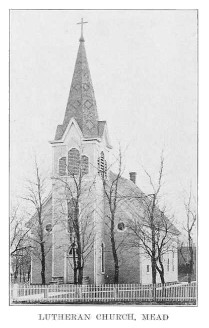
Lutheran Church, Mead

Baptist Church, Mead
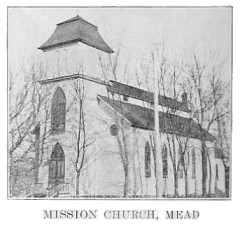
Mission Church, Mead
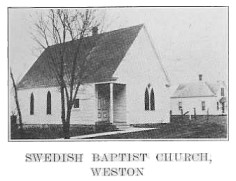
Swedish Baptist Church, Weston
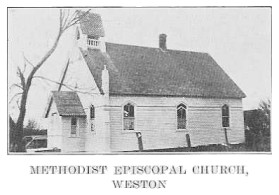
Methodist Episcopal Church, Weston
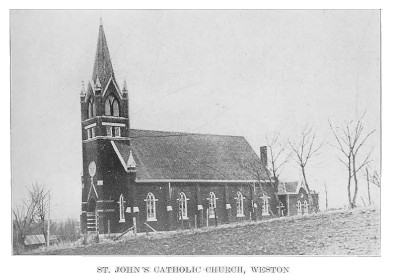
St. John's Catholic Church, Weston
PAST AND PRESENT OF SAUNDERS COUNTY 175
Reverend Lathrop preached the first sermon in Richland Precinct, at the house of B. W. Riddle, in the spring of 1872, and there organized a class of the Methodist Episcopal Church. In the following year Reverend Clark visited the settlement at Ceresco, preaching at intervals, during which time the organization of a Methodist Episcopal Sabbath School was effected. At Swedeburg a Lutheran Church was founded in 1872 and in 1876 the church was divided and a second established. Reverend Amlong organized a Presbyterian Church at Ceresco in 1875.
In Center Precinct Father Gregory preached the first sermon in 1869, using the schoolhouse on section 16, which had just been opened. He also formed a Methodist Episcopal class in the winter of that year.
Rev. George Worley preached the first sermon in Newman Precinct at the schoolhouse in 1868 and in the following year the Methodist Episcopal Church was organized.
|

